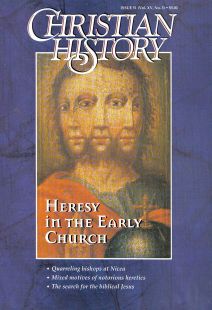Christian History Timeline: Heresy in the Early Church
GNOSTICISM
c. 140 Valentinus begins teaching Gnostic views in Rome
144 Marcion is excommunicated for Gnostic-like views
c. 175 Basilides espouses Gnostic teachings in Alexandria
c. 180 Irenaeus writes Against the Heresies, opposing Gnosticism
c. 450 Gnostic sects diminish
Forms of Gnosticism return with Paulicians (800s) and Albigensians (1200s)
QUARTODECIMANISM
c. 155 Polycarp and others from Asia Minor advocate Nisan 14 as date of Easter
c. 190 Pope Victor insists on Sunday observance and tries to stamp out Quartodecimanism (“14th—ism”), though Irenaeus advocates tolerance
325 Council of Nicea accepts Alexandrian method of determining Easter
400 Rome begins using Alexandrian method
In the Middle Ages, the Celtic church (in 625) and the church in Gaul (in the 800s) join the West in adopting the Alexandrian method
MONTANISM
c. 157 Montanus begins prophesying that the Heavenly Jerusalem will soon descend in Phrygia, in Asia Minor
170s Montanism develops ecstatic and ascetic practices
c. 190 Montanism condemned by church councils in Asia Minor
c. 207 Tertullian converts to Montanism
c. 400 Montanism wanes but survives in pockets
Though severly persecuted by Justinian I (483–565), Montanism survives into the 800s
MONARCHIANISM
c. 190s Monarchianism (emphasizing God’s monarchia, “unity”—not the three persons) spreads
c. 200 Noetus condemned at Rome for Patripassianism (“the father suffers-ism”), the teaching that the Father suffered as the Son
268 Council of Antioch deposes Paul of Samosata and condemns Sabellianism (i.e., modalism: Father, Son, and Spirit are temporary manifestations of the same being)
By the early 300s, most Monarchianists become Arians
“PURITANISM”
249–250 Decian persecution causes many Christians to “lapse,” i.e., deny the faith
251 Novatian teaches that the lapsed should not be readmitted to the church; some Christians admit the lapsed on easy terms
252 Cyprian argues for middle view: penance for the lapsed
255–256 African bishops insist on rebaptism of heretics and schismatics; Rome disagrees
311 Donatists refuse to accept new bishop of Carthage because he “handed over” the Scriptures under persecution; they consecrate a rival bishop
314 Council of Arles condemns Donatism, which insists on unwavering loyalty of church members
411 Donatism significantly weakened by government condemnation
Donatism survives in pockets in Africa until Islam conquers the region (late 600s)
ARIANISM
c. 318 Arius’s views, that Jesus is not divine, gains popularity; Athanasius writes On the Incarnation, affirming the full deity and humanity of Jesus
325 Council of Nicea, called by Emperor Constantine, condemns Arians and affirms the divinity of Christ
328–361 Temporary triumph of Arianism; period of factions and confusion; Nicene bishops, like Athanasius, are deposed and banished
337 New Eastern emperor, Constantius, openly embraces Arianism
c. 340 First conversions of Goths by Arian Ulfilas
361 Valentian, an orthodox, becomes Western emperor, and orthodoxy begins to recover lost ground
381 Theodosius, an orthodox, becomes sole emperor; Council of Constantinople affirms Nicene orthodoxy; Cappadocian Fathers put final touches on Trinitarian doctrine
390s Arianism still alive among the Goths and other Germanic peoples
Arianism disappears in the 700s through gradual conversion to orthodoxy
MONOPHYSITISM
371 Apollinarius’s views (an early form of Monophysitism [“one-naturism”]: Jesus has one, divine nature) spread
381 Council of Constantinople condemns Apollinarianism
440s Eutyches begins teaching Christ has only one nature after the Incarnation—a divine nature
449 Through intimidation and bribery, a council at Ephesus (the “Robber Council”) declares Eutyches orthodox
451 Council of Chalcedon proclaims that Christ has two natures and condemns Monophysitism
In the 500s, after repeated attempts at reconciliation, Monophysites consolidate in Coptic, Syrian, and Armenian communions
PELAGIANISM
c. 390 Pelagius moves to Rome and is disturbed by moral laxity
c. 410 Pelagius teaches salvation by good works; some of his followers deny original sin
c. 411 Augustine begins writing against Pelagius
418 Council of Carthage affirms Augustine’s teaching
431 Council of Ephesus condemns Pelagianism
With the condemnation at the Council of Orange (529), Pelagianism dies out
NESTORIANISM
428 Nestorius objects to calling Mary Theotokos (“God-bearer”), but Cyril of Alexandria defends the term and condemns Nestorius
431 Council of Ephesus declares Mary Theotokos and condemns Nestorianism
436 Nestorius banished to Upper Egypt
451 Council of Chalcedon condemns Nestorians, who gradually move to Persia and further east to form their own church
Nestorians remain a separate church to this day
By Bradley Nassif
[Christian History originally published this article in Christian History Issue #51 in 1996]
Bradley Nassif is visiting professor of Eastern Orthodoxy at Trinity Evangelical Divinity School in Illinois. He is editor of New Perspectives on Historical Theology (Eerdmans, 1996).Next articles
From the Editor — How to Read This Issue
Not every heresy is covered in depth, and not every teaching is defined thoroughly—there just isn’t space.
Mark GalliHeresy in the Early Church: Recommended Resources
More resources for further information on heresy in the early church.
David WrightChristian History Infographic — Sifting Through the Christ Controversies
A quick summary of the competing schools of thought.
the EditorsSupport us
Christian History Institute (CHI) is a non-profit Pennsylvania corporation founded in 1982. Your donations support the continuation of this ministry
Donate



